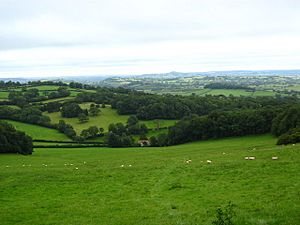Rodney Stoke SSSI facts for kids
| Site of Special Scientific Interest | |
 |
|
| Area of Search | Somerset |
|---|---|
| Coordinates | 51°15′11″N 2°43′45″W / 51.25319°N 2.72930°W |
| Interest | Biological |
| Area | 69.6 hectares (0.696 km2; 0.269 sq mi) |
| Notification | 1957 |
Rodney Stoke is a special natural area in the Mendip Hills of Somerset, England. It covers about 69.6 hectares (172 acres). This area was officially recognized in 1957 as a Site of Special Scientific Interest (SSSI). This means it's a place with important plants, animals, or geology that needs to be protected.
Part of Rodney Stoke is also a national nature reserve. These reserves are places where nature is looked after very carefully. Rodney Stoke is a mix of old woodlands, bushy areas, and grasslands full of different plant species. It sits on the steep, southwest-facing slopes of the Mendip Hills.
Contents
What Makes Rodney Stoke Special?
Rodney Stoke is important because it has a mix of different natural habitats. These include ancient woodlands, which are forests that have been around for a very long time. There are also areas of scrub (bushes) and grasslands that haven't been changed by farming. This variety helps many different kinds of plants and animals to live here.
The Rocks Beneath the Ground
The ground at Rodney Stoke is made of different types of rocks. Some are from a period called the Triassic time, and they are a type of rock called dolomitic conglomerate. This is like a mix of pebbles and stones cemented together. Other rocks are Carboniferous Limestone, which formed even earlier. These limestone rocks are mostly found in the woodlands called Big Stoke and Little Stoke.
Ancient Woodlands and Their History
The woodlands at Rodney Stoke, including Big Stoke, Little Stoke, and Calve's Plot Wood, are considered ancient woodlands. This means they have been continuously wooded for hundreds of years. However, Big Stoke and Little Stoke were almost completely cut down during World War I. Even after being cut, they are still considered ancient woodlands because the land has remained a forest.
Special Plants of Rodney Stoke
Rodney Stoke is home to some very rare plants. These plants are not found in many other places in the country. Protecting this site helps these special plants survive and thrive.
- Purple Gromwell (Lithospermum purpurocaeruleum): This plant has beautiful blue-purple flowers. It's quite rare to find in the UK.
- Whitebeam (Sorbus anglica): This is a special type of tree. It's an "endemic" species, which means it grows naturally only in certain parts of the UK, including this area.
Amazing Animals of Rodney Stoke
Rodney Stoke is also a great place for many different animals. The varied habitats provide homes and food for a wide range of creatures, from mammals to tiny insects.
Mammals and Birds
You can find several interesting animals living here:
- Badgers (Meles meles): These striped mammals are common at Rodney Stoke. They live in underground homes called setts. Two or three badger setts are usually active each year.
- Bats: Two types of bats, Noctule bats (Nyctalus noctula) and pipistrelle bats (Pipistrellus pipistrellus), use Big Stoke woodland as a place to roost. Roosting means they rest or sleep there during the day.
- Birds: Many birds breed in the area. These include the large buzzard (Buteo buteo) and the spotted flycatcher (Muscicapa striata).
Incredible Invertebrates
The small enclosures and tall hedges at Rodney Stoke create sheltered spots. These conditions are perfect for many species of invertebrates. Invertebrates are animals without backbones, like insects and spiders.
- Butterflies: Rodney Stoke is especially good for butterflies. Some of the beautiful species you might see include:
- Marbled white (Melanargia galathea)
- Purple hairstreak (Quercusia quercus)
- Brown argus (Aricia agestis)
- Grayling (Hipparchia semele)

